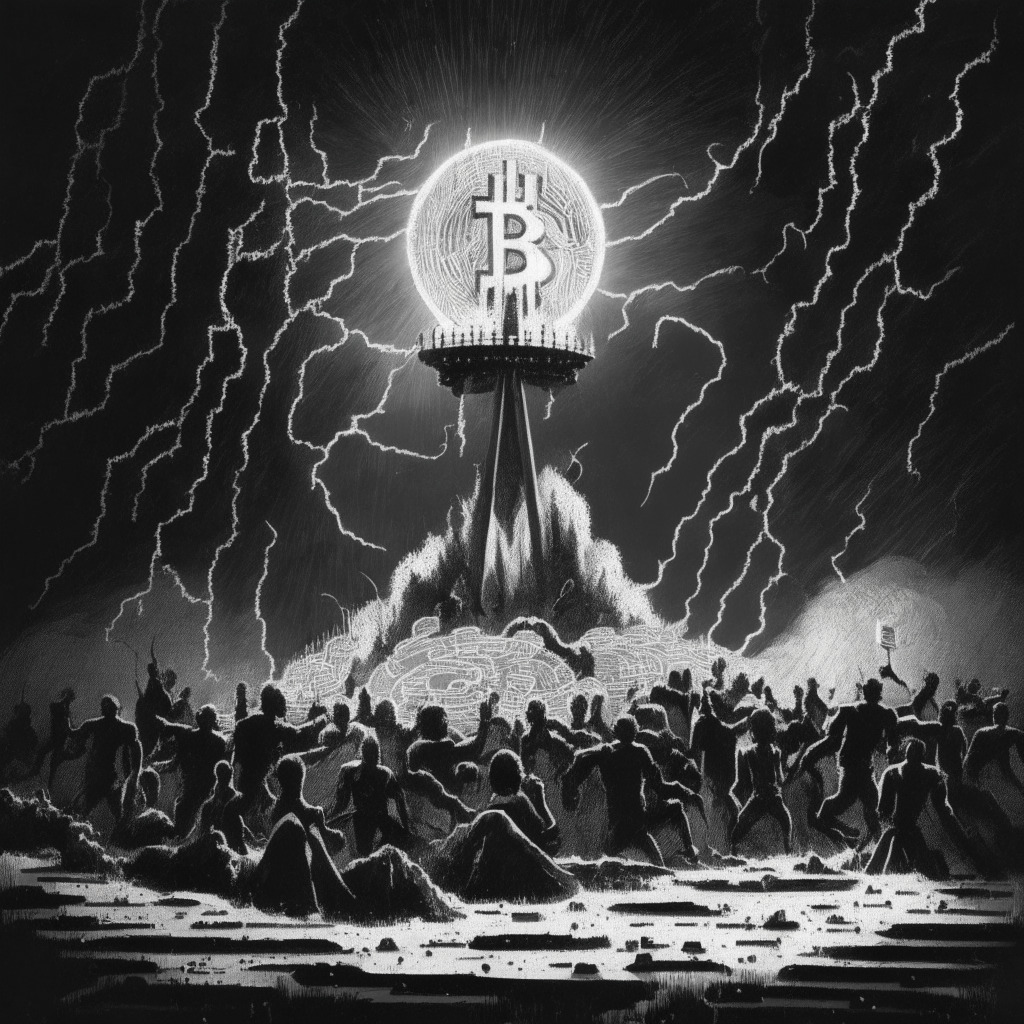In this article, we explore the recent 10% drop in Bitcoin value, critiqued regulatory methods of the US’s Securities and Exchange Commission and its influence on Bitcoin’s price fluctuation. A looming economic disaster by Federal Reserve policy mishaps is also cautioned, potentially influencing the future trajectory of Bitcoin.
Search Results for: Ripple Labs Inc
Longest Negative Year for Bitcoin: A Dark Tunnel with Light at its End?
Despite Bitcoin’s recent longest negative year-over-year returns, Dan Morehead, founder of crypto investment firm Pantera Capital, remains optimistic. He believes the half-cut of the BTC block reward for mining in April 2024 will propel bitcoin’s price. His models suggest that bitcoin will reach around $35,500 by the halving and nearly $150,000 by late 2025. Amid market fluctuations, Bitcoin’s future trajectory continues to raise questions.
Evolving Regulation & Legal Proceedings: A Tug of War in the Crypto Industry
“The U.S. Securities and Exchange Commission (SEC) is in a legal tussle with Ripple Labs and crypto exchange Gemini over regulatory laws and digital assets. The outcomes of these cases could significantly shape future blockchain-related lawsuits, highlighting the need for a clearer, adaptable legal framework for digital assets.”
Navigating the Tumultuous Seas of XRP: A Tale of Lawsuits, Market Volatility, and Rising Adoption
XRP’s value has stabilized around $0.50, amidst ongoing legal proceedings with the SEC. Despite this, adoption of XRP is increasing, with companies like MoneyGram planning to utilize it for cross-border transactions. However, SEC’s continued appeal creates potential volatility.
Rollercoaster Crypto Week: SEC Clashes, Price Tumbles, and Emerging Global Acceptance
This week in the crypto world saw a tumultuous phase as the SEC continues its litigation against Ripple Labs, while Bitcoin and Ethereum prices took a plunge. However, there are signs of hope as the EU welcomes its first Bitcoin ETF, and Coinbase gets regulatory approval for offering Bitcoin and Ethereum futures contracts.
Unleashing XRP Options on Bit Exchange: A Game-Changer Amid Uncertainty
“Bit Exchange now offers XRP-linked options, allowing users to trade XRP options without owning the cryptocurrency. Despite legal proceedings surrounding Ripple Labs, this move makes Bit Exchange a pioneer in offering XRP options trading to both institutional and retail traders.”
XRP Options Launch on Cryptocurrency Exchange BIT: A Game-Changer or a Risky Move?
Cryptocurrency derivatives exchange BIT has launched options connected to the payments-focused cryptocurrency XRP, allowing traders to speculate on XRP options without actually owning the cryptocurrency. This adds to BIT’s existing options, which also cover cryptocurrencies like bitcoin, ether, and Cardano’s ADA.
The Crypto Rollercoaster: Navigating Thrilling Highs, Crushing Lows and the Future of the Industry
“The ‘Greed & Fear’ index signifies a significant shift in the crypto sector, where recent Bitcoin resilience and optimistic judicial proceedings with the SEC indicate a promising future. Despite potential hurdles such as changing “custody rule” and the threat of quantum computers, Bitcoin’s technological prowess remains untouchable, fuelling innovation and unrestricted transactions.”
The Diverging Pathways of Optimism Token and Emerging Challenger XRP20
“The Optimism token (OP) is seeing potential downward trend after losing support from the 20-Day Moving Average (20DMA). Despite a risk-reward ratio not in its favor, Optimism’s Relative Strength Index shows hope for upturn. In contrast, XRP20, an Ethereum-compliant ERC20 token offers new utility in the XRP space and enticing staking rewards, ahead of traditional XRP.”
Navigating the Summer Slump: A Mixed Bag for the Crypto Market
“The crypto market experienced a summer slump with the excitement over Bitcoin ETFs declining. However, altcoins like XRP thrived, and publicly traded crypto companies saw an average rise of 23.9% in stock prices. Despite the bear market affecting NFTs and security concerns in the DeFi sector, the crypto industry continues to evolve, offering new opportunities and challenges.”
Unraveling the XRP Surge to $50: An Anomaly or a Market Statement?
XRP experienced a brief, electrifying surge to $50 on the crypto exchange, Gemini, possibly due to an unusually large market order during a liquidity dry spell. This price instability highlights the potential and need for greater stability and regulatory measures in the rapidly evolving cryptocurrency world.
XRP vs XRP20: A Tale of Uncertainty, Innovation, and the Future of Crypto Markets
The XRP20 stake-to-earn coin garners investor attention with $1.84m inflows, swiftly approaching its $3.68m presale cap. Its strategy involves staking and burning, making it increasingly scarce, along with fostering transparency and decentralization unlike XRP’s centralized model. Despite advantages, XRP20 has its own high-risk investment realities and remains in Ethereum’s shadow.
Navigating the NFT Dip: DeGods Defies Market Trends and Plans Expansion Amid Declining NFT Volume
Despite a 50% drop in overall NFT trading volume since January, DeGods, a PFP project, shows resilience with a 197% surge in trading volume to about $2.5 million. It coincides with the purchase of 158 DeGods, placing DeGods at the top of OpenSea’s leaderboard. However, DeGods’ floor price declined during this sales burst, suggesting fluctuating NFT sales trends. DeGods recently announced “Season III” which will introduce 20,000 new artworks and renew unattractive traits, initiating an intriguing wave in the NFT market.
Navigating the Rocking Boat: RNDR’s Strained Journey vs. XRP20’s Rising Popularity
After a massive price retracement, RNDR, the leading Web3 GPU project, shows signs of life at the $1.50 lower trendline. However, the future remains uncertain due to the dreaded ‘death cross’ in its graph. Meanwhile, XRP20, staking promising returns, has been gaining traction among prudent investors, strongly benefiting from its position on the Ethereum network. Its significantly lower price than XRP and a 0.1% burn mechanism make it an attractive option in the crypto market.
Evaluating Cryptocurrency Growth: Past Performance & Future Prospects in a Volatile Landscape
The cryptocurrency circle has seen significant changes since 2017, with Bitcoin hitting a remarkable peak. Top cryptocurrencies have shown remarkable resiliency and growth, sparking interest from investors. However, volatility and legal issues also punctuate the market, prompting the need for investor caution.
Navigating the Tempest: The SEC, Richard Heart, and Allegations of Crypto Deception
The U.S. Securities and Exchange Commission (SEC) is pressing charges against Richard Heart, the backer of projects Hex, PulseChain and PulseX, accusing him of fraudulent practices. Heart allegedly recycled investment funds during Hex’s inception phase, effectively inflating initial investment, attracting more victims, and misleading investors with a fictitious “staking” program. This serves as a warning to evaluate the underlying technology and financial models of investment targets.
Cryptocurrency Variance: Analyzing July’s Market Performances and Looming Prospects of Diverse Crypto Markets
“MakerDAO’s MKR advanced by a remarkable 47% in July, outpacing other Coindesk Market Index constituents. Ripple Labs’ XRP followed closely with a growth of 46.6%, linked to a U.S. Judge’s ruling. Contrastingly, Bitcoin and Ether each lost 4% in July, shedding light on the unpredictable volatility of cryptocurrencies.”
Curve Finance Hack and the Tentative Balance in DeFi’s Future
“The DeFi segment suffered a setback when Curve Finance, an Ethereum-based decentralized exchange, was hacked, leading to a 20% price drop in its token (CRV). Founder Micheal Egorov’s substantial loans backed by CRV triggered a panic-induced price drop. However, Egorov’s partial loan repayments and an intriguing pattern in the derivatives market suggest a potential near-term rally for CRV.”
BlackRock CEO’s Bitcoin Conversion: A Turning Point or Mere Market Strategy?
Outspoken CEO of BlackRock, Larry Fink, a former Bitcoin critic, has now endorsed the cryptocurrency, triggering positive reactions. His change of stance first became noticeable when BlackRock submitted an application for a Bitcoin spot ETF. Fink’s newfound Bitcoin approval and BlackRock’s ETF aspirations could trigger an “adoption cycle” and potentially help Bitcoin exceed its record high.
The Advent of XRP20: A Promising New Crypto Revolution or a Risky Bet?
XRP20, a derivative coin of Ripple’s XRP, is seizing attention in the cryptocurrency realm with its staking, burn mechanism, and alleviation of token centralization concerns. While promising, potential investors must exercise due diligence due to inherent risk in cryptocurrency.
US Defense Bill’s Impact on Stablecoins: A Compliance Conundrum in the Offing
The U.S. national defense bill could pose compliance challenges for stablecoins like USDC due to proposed Know Your Customer (KYC) and anti-money laundering (AML) measures. The standards may affect stablecoin holders’ identities and impact USDC’s market cap. The bill’s implications could also affect Coinbase, which derived almost 27% of its net revenue from USDC in Q1 2021.
Decentralized Exchange dYdX’s Critical Decision: Cut Rewards and Save a Million or Preserve Status Quo?
“dYdX community members are deciding whether to cut rewards for liquidity providers or maintain the current structure. If approved, the proposal could save the business $1 million monthly and reduce issuance of its dYdX token. However, limiting the token issuance could potentially boost their prices, resulting in a communal benefit.”
BlackRock and the Anticipation of Bitcoin Spot ETFs: A Glimmer of Hope or a Brewing Storm?
BlackRock, along with Fidelity and Ark Investments, have filed for Bitcoin spot ETFs potentially signalling a new wave of institutional investments into digital assets. This would grant investors direct access to Bitcoin, possibly cause a price surge, but could also lead to capital outflows from mining stocks to more regulated, potentially profitable Wall Street financial products.
Institutional Embrace of Altcoins Amid Regulatory Uncertainties: A Deep Dive
Institutional investors have surged their investments in altcoin-based products such as XRP, Stellar’s XLM, and Solana’s SOL, despite a tentative market sentiment. Products based on these coins saw significant growth in assets under management, with Stellar’s XLM witnessing a remarkable 62.7% increase.
Bitcoin Surfs Above $29,000 Amid U.S. Monetary Shift: Musk’s DOGE, Market Outlooks, and Inflation Fears
Despite the U.S. Federal Reserve’s impending hawkish shift, BTC maintains support above $29,000, while most other cryptos face a gloomy market. DOGE uniquely rose 8%, potentially due to rumors of wider crypto usage in Elon Musk’s new Twitter platform, X.
Exploring the $201.4 Million Crypto Funding Boom: Who are the Big Winners?
“Despite a decline in crypto fundraising in June 2023, continuous momentum of investments in the space promises a bright future for crypto innovations and growth. The overall trend indicates venture capitalists’ attention towards crypto remains unhindered, with potential for growth appearing optimistic.”
A Look into the Future: AI and Blockchain Synergies at EthCC Paris Conference
The Ethereum-focused conference EthCC witnessed buzz due to potential shift in the crypto market and the confluence of AI with blockchain technology. Future prospects of AI in crypto financial markets and valuating non-fungible tokens were discussed. Skepticism around use-cases and computational demands of AI and blockchain intersection remain.
Bitcoin’s Tense Brawl with the $29,500 Support Level: How the Federal Reserve Meeting Could Revive It
Bitcoin continues to hover around the $29,500 support level amid a lack of major economic events or institutional adoption updates. Traders are closely monitoring BTC’s 21-Day Moving Average, a critical barrier for short-term gains. Meanwhile, upcoming Federal Reserve policy changes could trigger movement in Bitcoin markets. Optimism about potential institutional adoption, positive technical indicators, and easing financial conditions could drive Bitcoin’s performance.
Analyzing XRP’s Future: Court Rulings, Network Adoption, and Price Volatility
“The future of XRP is driven by market speculation and network adoption. With a mix of positive regulatory development, technical progress, and increased retail user base, XRP’s downward trend could potentially end. However, near-term future volatility is expected.”
Shaking Up the Crypto Regulation: Is the SEC Missing the Boat?
“Congressman Ritchie Torres criticizes the SEC’s inconsistency in crypto regulations, creating uncertainty. Following the Ripple Labs case ruling, which denotes XRP isn’t a security, the SEC’s crackdown on crypto is scrutinized, highlighting the need for clear, consistent guidelines in the evolving digital marketplace.”
Bear vs Bull: Navigating Bitcoin’s Price Amid Unstable Market Factors and Political Influences
“Cathie Wood from Ark Invest forecasts Bitcoin’s price to reach up to $1.5 million by 2030, highlighting growing trust in the cryptocurrency. Despite US Congressman Ritchie Torres’ concerns over SEC’s stance towards cryptocurrency, Bitcoin’s resilience remains strong above the $30,000 mark.”
Futureverse Bags $54M: Pros, Cons and Impact on Bear Market Conditions
“Futureverse, a blend of 11 firms, recently secured $54 million in a Series A round. Involved in AI and blockchain tech, it aims to enhance the metaverse user experience. Despite prevailing bear market conditions, such intersectional projects attract investor optimism, possibly signifying a shift in the digital asset industry.”































